|
|
Updated as per James P. Tuttle's The Hawk Moths of North America, January 23, 2009
|
King County, Washington
Sphingidae
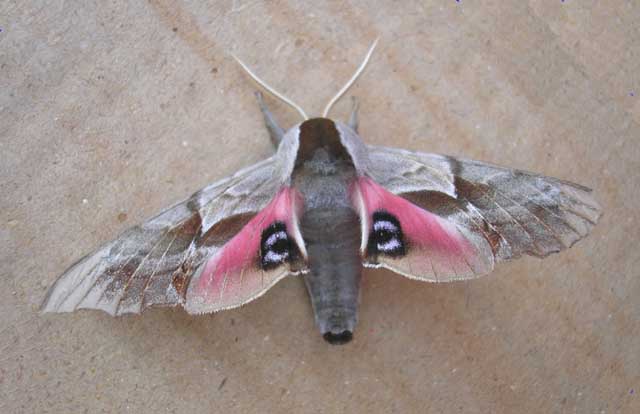
Smerinthus cerisyi, Seattle Washington, May 31, 2007, courtesy
of Molly Kuehn.
Seventeen Sphingidae species are listed for Washington. Not all
of the species are reported or anticipated in King County (only three
on USGS) in southwestern Washington. It is hoped that
this checklist, with the thumbnails and notes, will help you
quickly identify the moths you have encountered.
The Cascades seem to be a barrier to some of the more eastern species.
A "USGS"
indicates the moth is reported in USGS and/or in Moths of Western North America,
#2. Distribution of Sphingidae of Western North America, revised,
an excellent little booklet available through Paul Opler.
A "WO" after the species name indicates that
I have no confirmed reports of this species in King County, but I
(William Oehlke) expect that this moth is or
might be present.
Please help me develop this list with improved, documented accuracy by
sending sightings (species, date, location), preferably with an
image, via email to
Bill Oehlke.
This page is dedicated to Molly Kuehn who sent me the
image of Smerinthus cerisyi at the top of the page.
Moll writes, "I found this moth by my door yesterday (05-31-07) in
Seattle's Magnolia neighborhood. I was looking to see what kind of
moth he was and ran across your info asking for data. Here are a few
pictures for you. Hope this helps
with your project."
Sphinginae subfamily
Sphingini tribe:
 |
This species is possibly present (unreported) and larvae feed on
tomatoes and go by the common name of
"Tomato Hornworms". |
 |
Forewings, long and slender, are held close to the body when the moth
is at rest.
I only see them occasionally on P.E.I. despite visiting lights
frequently. |
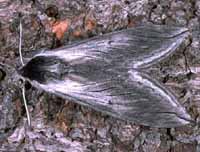 | The upperside of the forewing is dark grey to black with a
paler costa and pale area from the base to the wing's centre.
Prefered habitats include montane woodlands and mixed chaparral-type
vegetation. |
 |
The upperside of the forewing has a narrow black subterminal line
bordered by a white inverted V-shaped line on the outside, and a
black line running inwards from the apex of the wing.
It is most often found in montane woodlands and along streamcourses.
|
Smerinthini Tribe:
 |
This one is quite similar to Pachysphinx modesta, with modesta
being smaller and darker.
If you've got willows or poplars nearby, then you probably have
occidentalis in your immediate area.
|
 |
The grey-blue eyespot (without a black center pupil) of the hindwing gives this species its name.
Larvae feed on birches, willows, cherries and oaks.
The outer edge of the forewings is quite scalloped. |
Paonias excaecata, Kirkland, July 14, 2011, Harriette Dorkin
 |
If you have willows and poplars nearby, you've probably got populations of
the Cerisyi's Sphinx. The hindwings are quite striking.
|
Smerinthus cerisyi, Seattle, May 31, 2007, Molly Kuehn
Macroglossinae subfamily
Dilophonotini tribe:
 |
Hemaris diffinis
USGS, the Snowberry Clearwing or
Bumblebee Moth
This species is officially reported from King Co., and this day
flying moth is widely distributed in Washington. |
Macroglossini tribe:
 |
Hyles gallii
WO,
the Bedstraw Hawk Moth or Gallium Sphinx
This species is not reported from King County, but if
you have Gallium or Epilobium, you probably have
localized populations of this species. |
 |
Hyles lineata
DM, the White-lined Sphinx
This species is very widespread. It can be seen flying during the day,
into the evening and also at night.
The highly variable larvae are often found in people's gardens.
|
Hyles lineata, Dave McNeese, (10+) Fall City, May 13, 2005 nectaring at flowering Rhodes; 8:00 to 10:00 pm.
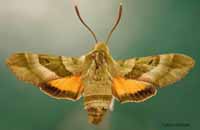 |
This day flier, April-June, prefers oak woodland and pine-oak
woodland in foothills. Moths nectar at a
variety of flowers in the afternoon.
|
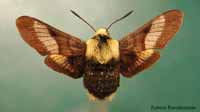 |
Proserpinus flavofasciata
USGS,
the Yellow-banded Day Sphinx
This day flier is officially reported from King and in
southwestern British Columbia in meadows near
coniferous forests. |
|
|
Enjoy some of nature's wonderments, giant silk moth cocoons.
These cocoons are for sale winter and fall. Beautiful Saturniidae moths will emerge the following spring and summer.
Read Actias luna rearing article. Additional online help available.
Use your browser "Back" button to return to the previous page.
This page is brought to you by
Bill Oehlke and the
WLSS. Pages are on space rented from Bizland. If you would like
to become a "Patron of the Sphingidae Site", contact Bill.
Please send sightings/images to Bill. I will do my best to respond to
requests for identification help.
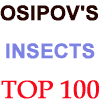 | 
Show appreciation for this site by clicking on flashing butterfly to the left.
The link will take you to a page with links to many insect sites. |

